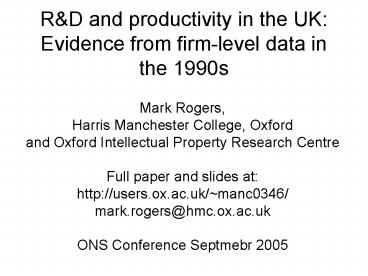R - PowerPoint PPT Presentation
1 / 16
Title:
R
Description:
Data on large UK companies (1989-2000) (max n=719, balanced and unbalance panel) ... firms that do R&D, but low past cash flow implies less likelihood of doing R&D ... – PowerPoint PPT presentation
Number of Views:20
Avg rating:3.0/5.0
Title: R
1
RD and productivity in the UK Evidence from
firm-level data in the 1990s
- Mark Rogers,
- Harris Manchester College, Oxford
- and Oxford Intellectual Property Research Centre
- Full paper and slides at
- http//users.ox.ac.uk/manc0346/
- mark.rogers_at_hmc.ox.ac.uk
- ONS Conference Septmebr 2005
2
UK Business RD / GDP
UK business RD (BERD) relatively low with
respect to G5. Slow decline in 1990s (average
1.30) 1980s (1.47)
3
Further issues in BERD fall
- Defence-related BERD has fallen in 80s/90s, but
civil BERD also small decline - Industry structure does not account for
differences with G5 UK firms have lower
intensity as well. UK SME sector has relatively
high BERD larger firms reverse. - Real RD spend increased in pharma. (1987 was 10
of total, now around 25). Services also
increasing. - UK has high of foreign funded BERD (22 in
1999 Germany 2.7)
These statements based on government analysis
in HM Treasury Science and Innovation Framework
2004-14. No formal, analytical papers.
4
This paper
- Data on large UK companies (1989-2000) (max
n719, balanced and unbalance panel) - These data 10.7bn RD in 2000, ONS estimate
11.5bn BERD for entire UK. - Analyse (gross marginal) rate of return to RD
- Why interested?
- Bond et al (2002) find that UK rate of return is
higher than Germany - implies constrained RD (financial or human
capital) ? specific policies - This consistent with older, anecdotal view,
that City of London not interested in RD.
5
Evidence on rates of return
- US studies (to mid80s) 0.13 to 0.25
- German/French studies 0.22 to 0.35
- Based on production function approach
6
from Table 4 in paper
7
UK rate of return?
- Above shows 0.18 to 0.25
- Have run IV and GMM models (RD coefficients 0.07
to 0.25 labour and capital coefficients
volatile) - Omitting highest RD intensity firms does raise
coefficient (to around 0.30) - Conclusion, no strong evidence that UK firms have
higher rates of return than German/French
8
Did rate of return change in 1990s?
- Firm-level data used here show temporary fall in
RD/value added in 96/97 do not mimic aggregate
data. - Using dummy variables for years, and interacting
with RD, find no evidence of changes in returns
over 1990s - Overall, no evidence of shifts in constraints on,
or demand for, RD during the 1990s
9
Financial constraints?
- Firms that are credit constrained in RD, should
have higher rates of return (i.e. profitable RD
projects they cannot fund) - Bond et al (2003) find no constraints for firms
that do RD, but low past cash flow implies less
likelihood of doing RD - Analyse difference between stock market listed
and non-listed, and also past profitability (NPBT
t-2, t-3) - Listed status has no significant role.
10
Past profitability and returns to RD
Coefficient on RD/value added stable No
evidence that RDers are credit constrained
11
Competition and returns to RD
- Basic theory suggests returns should vary with
competitive conditions - Very difficult to measure competition
- Greenhalgh and Rogers (2004) use profit
persistence and Pavitt sector methodology - Profit persistence uses pit fi bpit eit
- low b, means rapid adjustment back to normal
profits, high competition - Analyse this for six Pavitt sectors
12
Pavitt sectors
13
Low ? high competition
Low return in (competitive) science-based
sector Pharma. firms in sector 4 have returns of
0.14 UK science-based sector is unusual
14
Conclusions
- Results
- UK returns to RD roughly same as other
countries. - No evidence of changing returns in 1990s
- Listed status or past profitability no influence
on rates of return - Science-based sector has lowest returns, and is
also most competitive (according to profit
persistence)
15
Implications
- Why is UK BERD low?
- No evidence of high returns, implies finance/HK
constraints not the problem - Fact that returns similar to other countries, yet
RD low, implies low appropriability weak
demand - Excessive competition? (but intl markets?)
- Could be poor management and weak use of IP
- Further work
- role of international firms
- role of IP
- further analysis of pharmaceuticals, electronics
and electrical
16
Profit persistence analysis
Use PBT/Sales as p
High competition b ? 0 Low competition b ? 1

